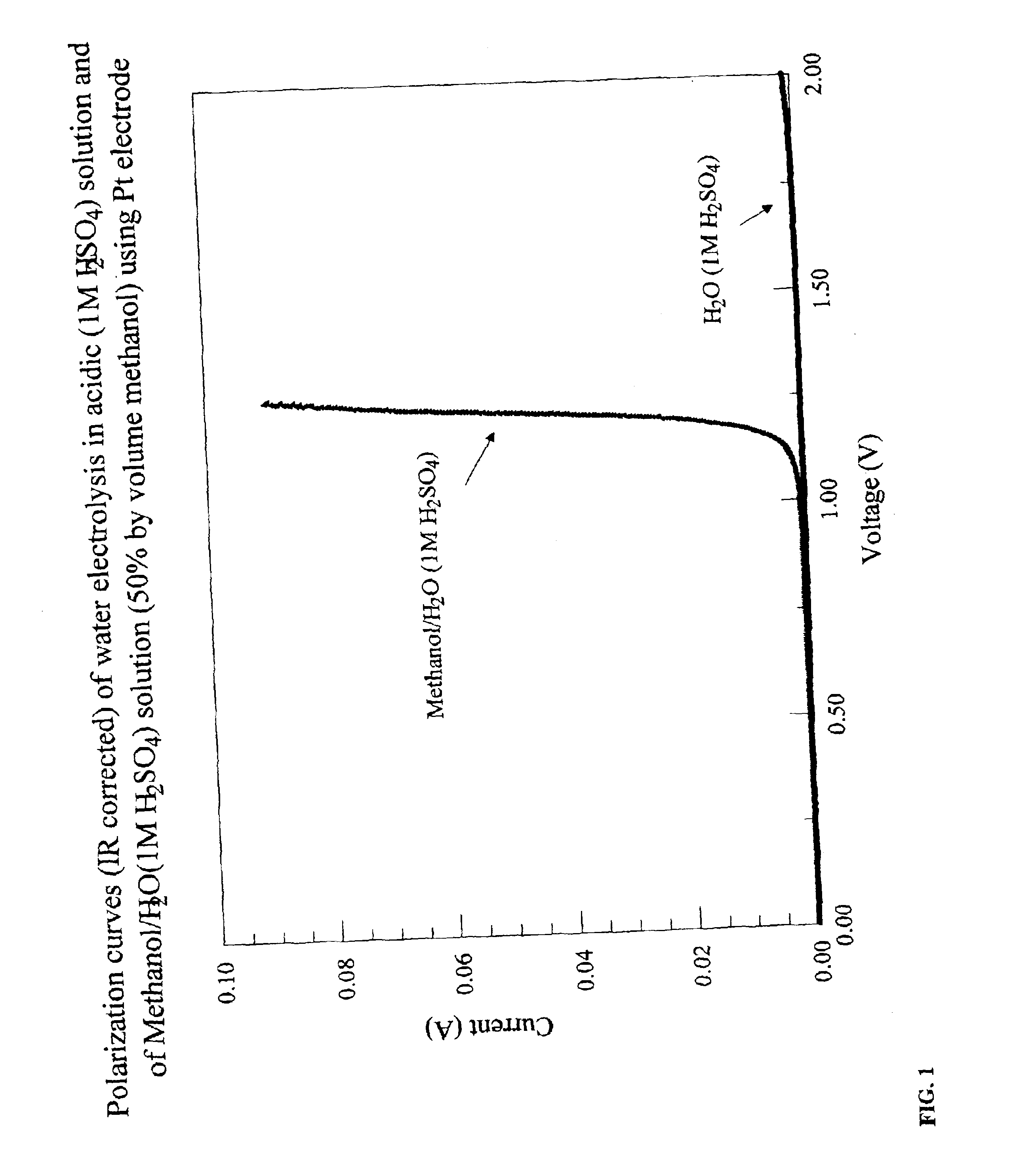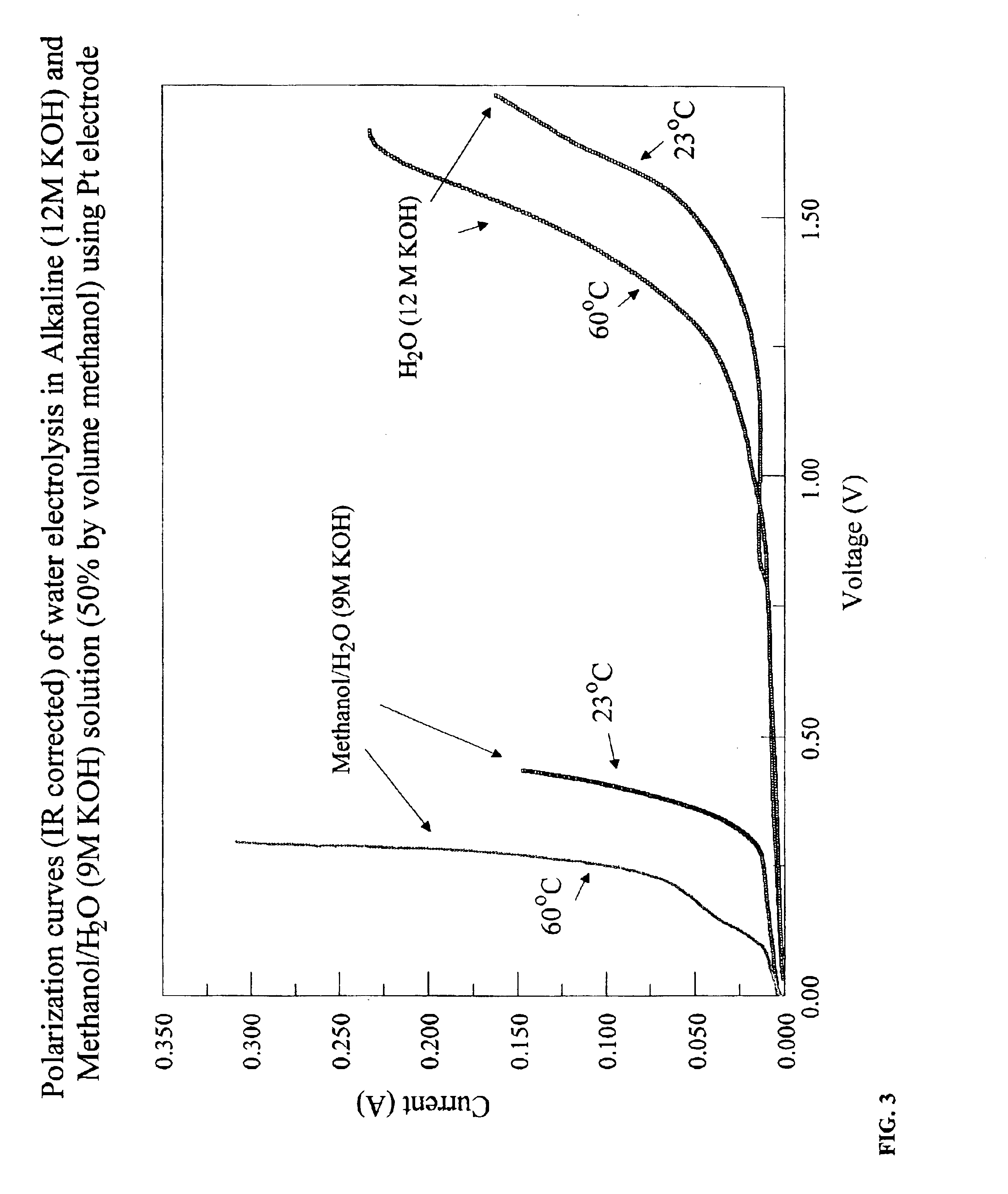Electrolytic production of hydrogen
a technology of electrolysis and hydrogen, which is applied in the direction of organic compounds/hydrides/coordination complexes, bulk chemical production, physical/chemical process catalysts, etc., can solve the problems of high polluting of fossil fuels, escalating costs, and fossil fuels being highly polluting. , to achieve the effect of reducing the number of oxidized substances
- Summary
- Abstract
- Description
- Claims
- Application Information
AI Technical Summary
Problems solved by technology
Method used
Image
Examples
example 1
[0047]In this example, one embodiment of methanol electrolysis according to the instant invention is described. The reaction was completed at room temperature in a testing electrochemical cell that included an anode, a cathode, and an electrolyte solution assembled within a 250 mL beaker. The anode included 20% Pt supported on high surface area carbon on a Toray paper substrate. The geometric area of the electrode was 4.1 cm2. The cathode was identical in design to the anode. The anode and cathode were separated by 5.5 cm in the testing electrochemical cell. The electrolyte solution consisted of 50 mL methanol and 50 mL of a 1M aqueous solution of sulfuric acid. The sulfuric acid is present as a conductivity-enhancing agent and is present at constant concentration during the course of the methanol electrolysis reaction.
[0048]For comparison purposes, an analogous electrochemical cell without methanol was constructed. The electrolyte in the comparison cell consisted of 100 mL of a 1M ...
example 2
[0054]In this example, production of hydrogen from the electrolysis reaction of methanol in the presence of a base is demonstrated. The reaction was completed in a testing electrochemical cell that included an anode, a cathode, and an electrolyte solution assembled within a 100 mL beaker. The anode included 20% Pt supported on high surface area carbon on a silver plated nickel substrate. The geometric area of the electrode was 2 cm2. The cathode was identical in design to the anode. The anode and cathode were separated by 1 cm in the testing electrochemical cell. The electrolyte solution consisted of 40 mL methanol, 20 mL water, and 60 g KOH. The KOH dissolved in the solution to provide hydroxide ion. The KOH was used as received from the vendor and may include adsorbed or hydrated water.
[0055]For comparison purposes, an analogous electrochemical cell without methanol was constructed. The electrolyte in the comparison cell consisted of 40 mL H2O and 120 g KOH. The KOH dissolved in t...
example 3
[0061]In this example, the production of hydrogen from methanol and water in the presence of KOH at 23° C. and 60° C. is demonstrated. The reaction at each temperature was completed in a testing electrochemical cell that included an anode, a cathode, and an electrolyte solution assembled within a 250 mL beaker. The anode included 20% Pt supported on a Toray paper substrate. The geometric area of the electrode was 4.1 cm2. The cathode was identical in design to the anode. The anode and cathode were separated by 5.5 cm in the testing electrochemical cell. The electrolyte solution consisted of a 100 mL portion of a solution formed by combining 250 mL methanol, 125 mL water, and 250 g KOH in a separate beaker. The KOH dissolved in the solution to provide hydroxide ion. The concentration of KOH in the electrolyte, expressed in molarity, is 9 M. The KOH was used as received from the vendor and may include adsorbed or hydrated water.
[0062]For comparison purposes, an analogous electrochemic...
PUM
| Property | Measurement | Unit |
|---|---|---|
| voltage | aaaaa | aaaaa |
| voltage | aaaaa | aaaaa |
| voltage | aaaaa | aaaaa |
Abstract
Description
Claims
Application Information
 Login to View More
Login to View More - R&D
- Intellectual Property
- Life Sciences
- Materials
- Tech Scout
- Unparalleled Data Quality
- Higher Quality Content
- 60% Fewer Hallucinations
Browse by: Latest US Patents, China's latest patents, Technical Efficacy Thesaurus, Application Domain, Technology Topic, Popular Technical Reports.
© 2025 PatSnap. All rights reserved.Legal|Privacy policy|Modern Slavery Act Transparency Statement|Sitemap|About US| Contact US: help@patsnap.com



